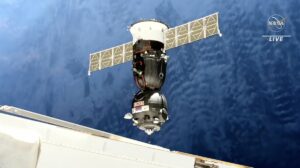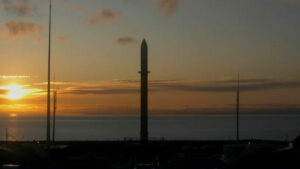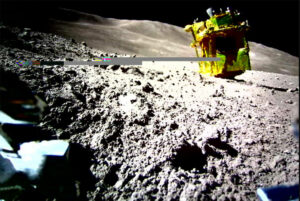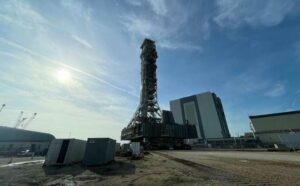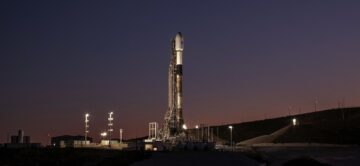
Blue Origin and Sierra Space announced Monday they are leading development of a commercial space complex named Orbital Reef. The companies said Orbital Reef will be operational by the time NASA and its partners retire the International Space Station.
The two privately-owned aerospace companies said they will work with Boeing, Redwire Space, Genesis Engineering, and Arizona State University to design, develop, build, and operate the Orbital Reef space station.
Brent Sherwood, Blue Origin’s senior vice president of advanced development programs, said the industry team is moving ahead, for now, to develop the Orbital Reef station using private funding. Officials hope to win government support in a public-private partnership arrangement through NASA’s Commercial Low Earth Orbit Destination, or CLD, program.
The Orbital Reef outpost will begin operations before 2030, officials said in a statement.
“Both Blue Origin and Sierra Space are private companies and are investing in Orbital Reef together,” Sherwood said in a press conference Monday at the International Astronautical Congress in Dubai.
“Orbital Reef provides world-class technical accommodations, and has a futuristic space architecture with all the features we should have in space: big volumes, big hatches, a sky canopy of huge windows facing Earth, a central thoroughfare between functional modules and a safe, easy way to do excursions outside,” Sherwood said.
Blue Origin, founded by Amazon.com billionaire Jeff Bezos, will provide the core module and solar power system for Orbital Reef. The company also plans to launch heavy elements of the space station using its reusable heavy-lift New Glenn rocket, which will take off from Cape Canaveral Space Force Station.
The New Glenn rocket is still in development, and Blue Origin says it won’t launch on its first test flight until the end of 2022, at the earliest.
Blue Origin also plans to develop a “last mile” space tug to help move elements between different orbits.
Sierra Space, a subsidiary of Sierra Nevada Corp., will supply its Large Integrated Flexible Habitat, or LIFE, module as living quarters for Orbital Reef’s crew. Sierra’s Dream Chaser cargo ship will be used for resupply missions to Orbital Reef.
The Dream Chaser, which takes off on a rocket and lands on a runway, is in development and scheduled to make its first trip to the International Space Station in late 2022 or early 2023, after launching on a United Launch Alliance Vulcan Centaur rocket, according to Janet Kavandi, president of Sierra Space.
Boeing will build a science module for Orbital Reef, and will operate and maintain the station. The company’s Starliner crew capsule, which is well along in development but has not yet flown with astronauts, will ferry people between Earth and Orbital Reef.
Redwire Space, which specializes in deployable space structures and in-space manufacturing, will provide roll-out solar arrays for Orbital Reef and accommodations for science experiments.
Other partners include Genesis Engineering, which will develop a “Single Person Spacecraft” for space fliers to conduct extravehicular excursions without the need for a spacesuit. Arizona State University leads a consortium of universities to provide scientific input and public outreach for the program.
“Whether your business is scientific research, exploration system development, invention and manufacture of new and unique products, media and advertising, or exotic hospitality, you’ll find a berth here,” the Orbital Reef partners said in a joint statement.
The companies released a four-minute promotional video on YouTube, featuring illustrations of the exterior and interior of the station. The video shows multiple inflatable habitats, several rigid-hull modules, and Dream Chaser and Starliner spacecraft docked to the space station.
Sherwood said Orbital Reef’s “baseline configuration” in the late 2020s will be about one-third that size, but still will be of “comparable scale” to the ISS.
“It’s a little smaller than the space station,” Sherwood said. “The power system is about the same, 100 kilowatts, but the capacity is 10 crew in that initial configuration, and it has a little bit over 90% of the interior volume that the station has today. Instead of being chopped up into smaller modules, it’s aggregated into a smaller number of larger modules with these more generous volumes.”
Orbital Reef will operate in a mid-inclination orbit about 310 miles (500 kilometers) above Earth, officials said.
The announcement makes Orbital Reef the third proposed commercial space station to be publicly disclosed. Nanoracks said last week it is partnering with Lockheed Martin on a space station program called Starlab.
Axiom Space plans to launch the first commercial lab module to the International Space Station in 2024 under an agreement with NASA. Axiom intends to eventually detach the pressurized module from the ISS to form the core of a new commercial space outpost.
Sherwood declined to put a cost figure on the Orbital Reef program, but said it will run “at least an order of magnitude” less than the estimated $100 billion cost of the International Space Station.
Kavandi also did not say how much Sierra Space will invest in Orbital Reef, but she said the private company has spent more than $1 billion of its own funding in the Dream Chaser program, alongside financial support from NASA.
Through its Commercial LEO Destinations program, NASA aims to help U.S. industry develop commercial habitats where NASA astronauts, foreign space fliers, and private astronauts could visit, live, and work after retirement of the ISS. NASA says it can be an anchor customer for a privately-owned research outpost in low Earth orbit, but the agency wants a commercial station to enable a growing space economy with a range of customers.
NASA hopes to keep the International Space Station operating until at least 2030, but eventually wants to transition responsibility for low Earth orbit stations to the private sector. Agency officials say that will allow NASA to focus its resources on deep space exploration.
Sherwood said private industry will have to shoulder the costs of any initial investment in a commercial space station.
“We are proceeding into full-scale development at this time in order to meet the schedule at the second half of this decade for operational capability,” he said.
It’s time for Congress to fund NASA’s part in developing a commercial space station to prevent a gap in U.S. presence in low Earth orbit after retirement of the ISS, said Mike Gold, Redwire’s vice president of civill space business development and external affairs.
“As much as we appreciate the ISS and will continue to leverage the ISS, it wasn’t built for business, and Orbital Reef will be able to unlock the opportunity for us to conduct microgravity research, development, manufacturing,” he said.
“We’ve seen great succsss with commercial space companies providing cargo, and more recently crew,” Gold said. “Now it is time to take that next step, that next quantum leap, to have the private sector deploy a platform.”
Email the author.
Follow Stephen Clark on Twitter: @StephenClark1.
- "
- 100
- Advertising
- Aerospace
- Agreement
- All
- Alliance
- Amazon
- announced
- Announcement
- architecture
- arizona
- Arizona State University
- bezos
- Billion
- Bit
- blue origin
- Boeing
- build
- business
- Canopy
- Capacity
- Cargo
- commercial
- Companies
- company
- Conference
- Congress
- continue
- Corp
- Costs
- credit
- Customers
- Design
- develop
- Development
- DID
- Dubai
- Early
- economy
- Engineering
- exploration
- facing
- Features
- Figure
- financial
- First
- flight
- Focus
- form
- fund
- funding
- gap
- Genesis
- Gold
- Government
- great
- Growing
- here
- hospitality
- How
- HTTPS
- huge
- industry
- International
- international space station
- investing
- investment
- IT
- jeff bezos
- large
- launch
- leading
- Leverage
- manufacturing
- Media
- Monday
- move
- Nasa
- NEVADA
- operating
- Operations
- Opportunity
- order
- partners
- Partnership
- People
- platform
- player
- power
- president
- press
- private
- Products
- Program
- Programs
- public
- Quantum
- range
- research
- Resources
- retirement
- Run
- safe
- Science
- Scientific Research
- Share
- Size
- solar
- Solar Power
- Space
- space exploration
- Space Force
- space station
- spacecraft
- specializes
- State
- Statement
- subsidiary
- supply
- support
- system
- Technical
- test
- time
- tweet
- u.s.
- United
- Universities
- university
- us
- Vice President
- Video
- volume
- week
- win
- windows
- Work
- youtube


